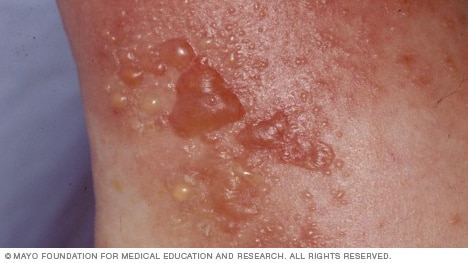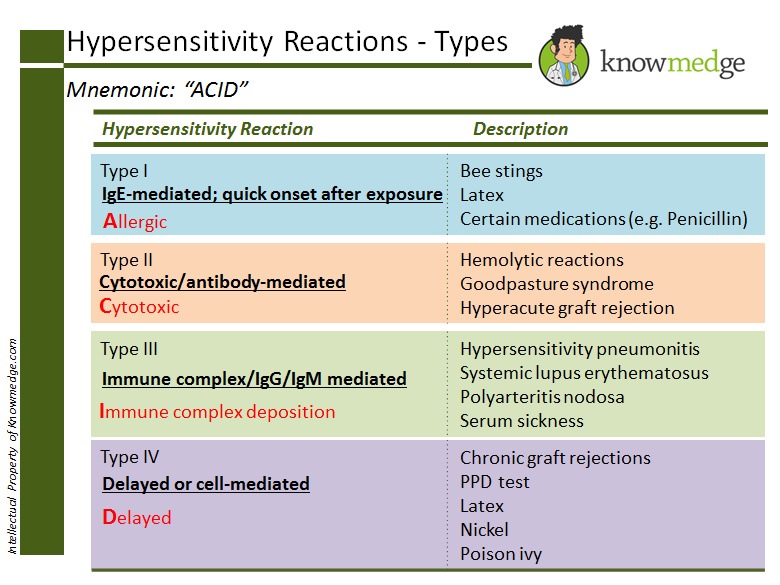Define edema/edematous.
Swelling caused by accumulation of fluid.
What is a normal BP in adults?
Approx. 120/80 mmHg

True or False: Someone with contact dermatitis should not scratch the affected area because it can easily lead to infection.
True.
Repeatedly scratching can lead to worsened irritation and to infections that in some cases, will require antibiotics.
What is calamine?
A topical/lotion used to relieve itching, pain, and discomfort from minor skin irritations such as poison ivy.
Briefly explain what contact dermatitis is.
Irritation or allergic reaction of the skin in response to directly coming into contact with a substance. Substances that cause a reaction can include, but are not limited to plants, soaps, cosmetics, jewelry, etc.
Shortness of breath
Dyspnea
What is skin excoriation?
Lesions on the skin that can result after trauma or injury. Individuals who pick at/scratch their skin can lead to excoriation. (mechanical means)
In the case of the patient, Mr. Schultz, what was the causative agent of his contact dermatitis. More specifically, what substance on the poison ivy plant resulted in an allergic reaction.
Urushiol
This oily resin is located in the leaves, stems, and roots of poison ivy, and small contact can cause an allergic reaction hours to days later.
True or False: Oatmeal baths are used to relieve minor irritation and itching by drying and removing the skins moisture; therefore, this remedy can be used to treat contact dermatitis caused by poison ivy.
FALSE
Oatmeal baths are used to hydrate the skin by locking in moisture. Additionally, oatmeal has properties that can help reduce inflammation and decrease itching.
True or false: There are two major types of contact dermatitis: Irritant and Allergic.
True

Define erythematous and conjunctival erythema
Erythematous: redness (or rash) of the skin or mucous membranes due to the accumulation of blood on dilated cappilaries.
Conjunctival erythema: tissue that lines the inside of the eyelids and covers the sclera becomes red.

What does it mean when blisters begin to weep and does this typically occur?
Weeping blisters refers to the release of fluid at the site of the contact dermatitis. This is a normal occurrence for this condition.
Was the patients travel history to the Guadalupe River pertinent to his case?
Yes, a camping trip to the Guadalupe river suggests close contact with the outdoor environment. Further, it may have been hard to determine a diagnosis without this information. It's also important to note that poison ivy is very prevalent in that area.
What are some ways to prevent contact dermatitis caused by poison ivy? (provide at least 2)
-avoid poison ivy plant as it contains urushiol (agent that causes allergic reaction)
-wash skin immediately if in contact with poison ivy.
-wear protective clothing (long sleeves and pants) in areas that potentially house poison ivy.
- apply a barrier cream (ivy blockers) to prevent urushiol from reaching the skin.
What are symptoms of contact dermatitis?
Presenting symptoms can include red and itchy rash, bumps and blisters that can ooze or crust, swelling and tenderness.

DEFINE PRURITIC
Unpleasant sensation that provokes the desire to scratch. Itchy skin.
Why was the rash isolated solely to the forearm?
Most likely, this was the area that was most exposed to the environment, thus most susceptible to poison ivy exposure.
True or False: patch testing is an effective way of determining a patients allergies and can there be used as a preventive measure by attempting to avoid certain allergens when possible.
True.
Patch testing is a technique used to detect allergens that are known to cause allergic contact dermatitis. Patches are typically applied on the back and analyzed 2 days later.
What are some adverse effects of high potency topical corticosteroids?
Adverse effects: In addition to itching, burning, and dryness, adverse effects include skin atrophy (reduction of epidermal and dermal thickness), widening of tiny blood vessels to make skin appear more thread-like, striae (stretch marks).
Contact dermatitis is considered a type IV hypersensitivity. Explain what this means and how this is different from other hypersensitivities.
Type IV hypersensitivity are cell-mediated rather than mediated by antibodies. This type of sensitivity is delayed as it can initiate a response several hours or even day(s) later. This reaction is mediated by T cells which recognize foreign substances and release inflammatory signals, cytokines as a response. Macrophages then become activated by these cytokines and attack-- initiating injury.
A substance that is not necessarily immunogenic independently, but when combined with a larger molecule can invoke an immune response.
Hapten
The loss of epidermis, caused by prolonged moisture and friction.
Denuded skin
Briefly explain the 4 types of hypersensitivities.

Why would antihistamines have little to no effect on a delayed type hypersensitivity?
Given that allergic contact dermatitis is a delayed hypersensitivity reaction, it undergoes a different immunologic mechanism than hives or anaphylaxis; therefore antihistamines wouldn't necessarily be helpful.
True or False: Allergic contact dermatitis can spread to other parts of the body.
False:
This is false due to the nature of its delayed onset of symptoms. In some cases, a rash or irritation may seem to spread; however, sometimes irritation present at different times. For example, areas that were least exposed to an allergen can present much later than at area that was more exposed or thicker skin may not react as fast as thin skin.